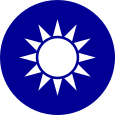
Back سياسة جمهورية الصين Arabic Държавно устройство на Тайван Bulgarian গণপ্রজাতন্ত্রী চীনের রাজনীতি Bengali/Bangla Política de Taiwán Spanish Politique à Taïwan French Politik Republik Tiongkok ID 中華民国の政治 Japanese 중화민국의 정치 Korean Politik Republik China Malay Política da República da China Portuguese
This article has multiple issues. Please help improve it or discuss these issues on the talk page. (Learn how and when to remove these template messages)
|
 |
|---|
|
|
Taiwan, officially the Republic of China (ROC), is governed in a framework of a representative democratic republic under a five-power system first envisioned by Sun Yat-sen in 1906, whereby under the constitutional amendments, the President is head of state and the Premier (President of the Executive Yuan) is head of government, and of a multi-party system. Executive power is exercised by the Executive Yuan. Legislative power is vested primarily in the Legislative Yuan. The judiciary is independent of the executive and the legislature. In addition, the Examination Yuan is in charge of validating the qualification of civil servants, and the Control Yuan inspects, reviews, and audits the policies and operations of the government.
The party system is currently dominated by two major parties: the Kuomintang (KMT), which broadly favors maintaining the constitutional framework of the Republic of China Constitution[1] and deepened economical cooperation with mainland China,[2] and the Democratic Progressive Party (DPP), which broadly favors de jure Taiwanese independence,[3] and the eventual abolition of the ROC Constitution in favor of creating a "Taiwanese Republic."[3]
Ever since the de facto end of the Chinese Civil War and the retreat of the government of the Republic of China to Taiwan, the modern-day ROC, or the "free area", currently consists of Taiwan Island, Penghu, Kinmen, Matsu and several smaller islands, including Taiping Island in the South China Sea. Taiwan's six major cities, Kaohsiung, New Taipei, Taichung, Tainan, Taipei, and Taoyuan, are special municipalities. The rest of the country is divided into 3 cities and 13 counties. Historically but no longer published since early 2000s,[4] the nominally de jure subdivided into 35 provinces, 1 special administrative region, 2 regions, and 18 special municipalities.
Prior to the constitutional reforms in 1991, the political system of Taiwan took place in a framework of a parliamentary representative democratic republic, where the President served a primarily ceremonial role as Head of State. Executive power was exercised by the government. Legislative power is formally vested in both the government and its tricameral parliament: the National Assembly where it elects the President and Vice-President as well as make major constitutional amendments, the Control Yuan and the Legislative Yuan.
Until the end of the martial law period in 1987, the Taiwanese political system under the KMT Dang Guo regime and White Terror was authoritarian, whereby political opposition was harshly suppressed, all religious activity controlled by the KMT, dissent not permitted, and civil rights curtailed.[5] After democratization in the 1990s, new political parties became legal, and restrictions on free speech and civil rights were lifted. The Economist Intelligence Unit rated Taiwan 8th place as a "full democracy" in 2022.[6] According to the V-Dem Democracy indices Taiwan was 2023 the second most electoral democratic country in Asia.[7]
Cite error: There are <ref group=note> tags on this page, but the references will not show without a {{reflist|group=note}} template (see the help page).
- ^ "政策綱領 - 中國國民黨全球資訊網 KMT Official Website". 中國國民黨全球資訊網. Retrieved 8 February 2024.
本黨遵守《中華民國憲法》、《中華民國憲法增修條文》及《兩岸人民關係條例》等相關法律規範處理兩岸關係,始終堅決反對「台獨」及「一國兩制」,堅決捍衛中華民國主權及自由地區民主憲政體制。
- ^ "政策綱領 - 中國國民黨全球資訊網 KMT Official Website". 中國國民黨全球資訊網. Retrieved 9 February 2024.
穩定兩岸關係以強化臺灣經濟,推動恢復兩岸制度性協商,提振兩岸經貿往來,重建爭端解決機制,維護臺灣農漁民權益,促進兩岸「優勢互補,互利雙贏」,共同因應全球區域經濟整合浪潮。
- ^ a b "DPP Charters" (PDF).
依照台灣主權現實獨立建國,制定新憲,使法政體系符合台灣社會現實,並依據國際法之原則重返國際社會。
- ^ "廢止「編印大陸地區地圖注意事項」" (in Traditional Chinese). 9 November 2004. Archived from the original on 3 January 2005.
九十三年十一月九日 (i.e. 2004-11-09)
- ^ "Remembering the Formosa Incident in Kaohsiung, Taiwan, 40 Years on". Archived from the original on 28 May 2022. Retrieved 28 May 2022.
- ^ "Democracy Index 2022: Frontline democracy and the battle for Ukraine" (PDF). Economist Intelligence Unit. 2023. Retrieved 9 February 2023.
- ^ V-Dem Institute (2023). "The V-Dem Dataset". Retrieved 14 October 2023.
© MMXXIII Rich X Search. We shall prevail. All rights reserved. Rich X Search

